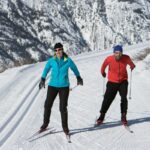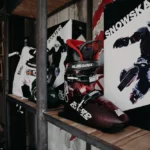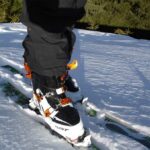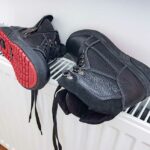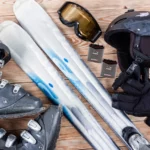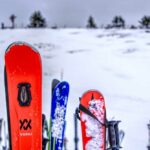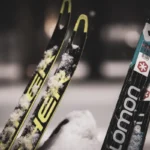The age-old debate between setting the slopes on fire on skis or tearing up the piste on a snowboard. Both skiing and snowboarding are exhilarating. It’s just a matter of what you prefer. Learning any new skill is a challenge.
Especially one as foreign as riding sliding pieces of flexible bamboo down a mountain covered in snow.
It can take some getting used to, and both skiing and snowboarding have their unique challenges.
A few things to think about before embarking on one or the other… Do you prefer the feeling of having your feet set sideways and tackling the slopes on a singular board with no poles to help you? Or do you prefer facing forwards, having two separate skis attached and ski poles in your hands?
For sure you have more pieces to think about and coordinate on skis but you also have the advantage of facing forwards which a lot of people prefer. Snowboarding is just you and the board, some people love the freedom and simplicity of this.
Pros Of Skiing For Beginners
Learning to ski no matter what age you are is a challenge. It takes perseverance and courage. Pointing yourself down a steep snow-covered mountain and just letting yourself go is a feeling a lot of people struggle with.
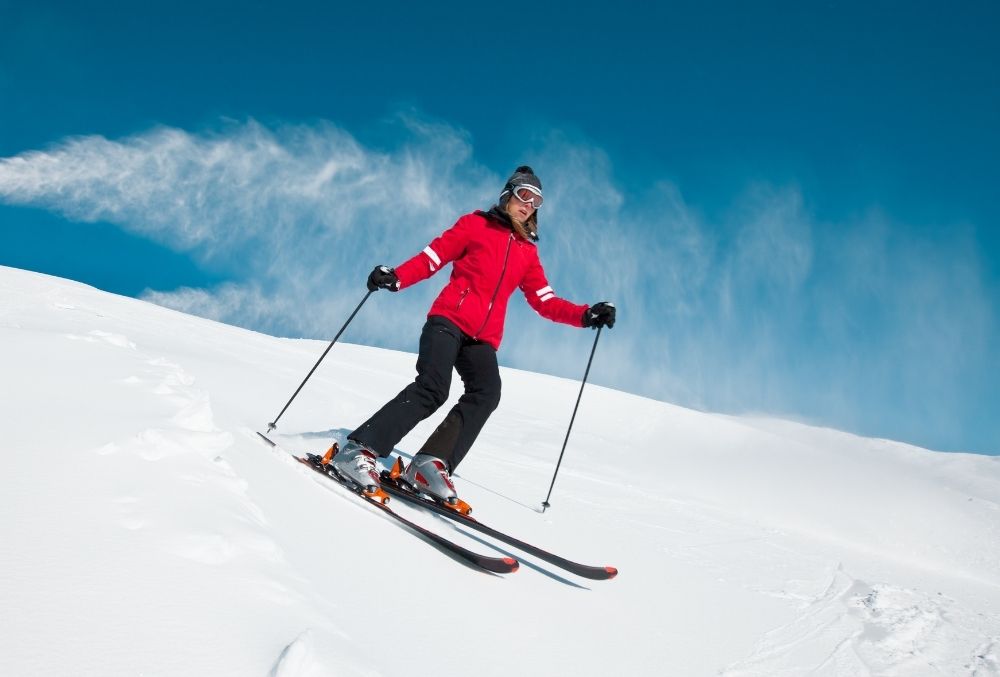
But once you surrender to this beautiful force and learn to work with it, dance with it, flow together like two perfectly synchronised elements, few feelings in the world can compare.
Ski Poles
The great thing about skiing is the ease of moving around the slopes and lifts. Having ski poles to push you on the flatter parts of the mountain once you have lost momentum helps you get to the places you want to go!
On a snowboard, once you lose your speed you have to hop or walk the flat parts, which takes far more time.
They also help you with keeping balance. If you feel you are falling over one side then you can use the pole to help regain balance by leaning on it.
Balance
In general, learning to balance on skis is relatively easier than balancing on a snowboard.
The fact you have two skis and the ability to move and adjust them separately can help when starting and is less punishing if you make a mistake. Being able to take one leg and move it outwards if you feel you are falling is a big help when starting.
You are also less susceptible to falling forwards or backwards due to the length of the skis and the direction they are facing.
You can get away with having your balance too far back or forward on skis, you won’t necessarily fall, even though it’s not an ideal technique and will affect how much control you have over the skis.
Forward-Facing
Facing forwards is a plus for many. Being able to see exactly what is in front of you and either side of you helps with feeling relaxed and simply feels more natural for some people.
Snow Plough
The snowplough is something you learn at the very beginning of skiing.
It is a technique taught to help you slow down by forming a V shape with the front of your skis to slow you down like a snowplough. This helps you from falling if you pick up too much speed and get scared.
Getting On Chair Lifts
Getting on chair lifts is a lot easier for skiers than snowboarders, especially in the beginning.
With skiing it is a case of timing when to sit down as the lift approaches from behind, keeping your skis together, trying not to take out anyone next to you!
Once you’re on you pull the bar down from above your head and rest your skis on the ski rests.
That’s all there is to it! Once you get to the end it’s a simple straight push off facing forwards and trying not to cross your skis. Again, this is far simpler than getting on and off with a snowboard half hanging from one foot.
Traversing
Traversing slopes is something you will do frequently after a few days on skis, once you’ve mastered the basics.
In many scenarios, you’ll want to traverse a slope trying to maintain your altitude to connect to another slope or make the right chair lift to get home without going too low and having to walk back up.
On skis due to the shape and the way they sit in the snow, they allow you to traverse very well keeping your altitude without sliding too far down the mountain. Skis also maintain their speed very well whilst traversing in comparison to snowboards.
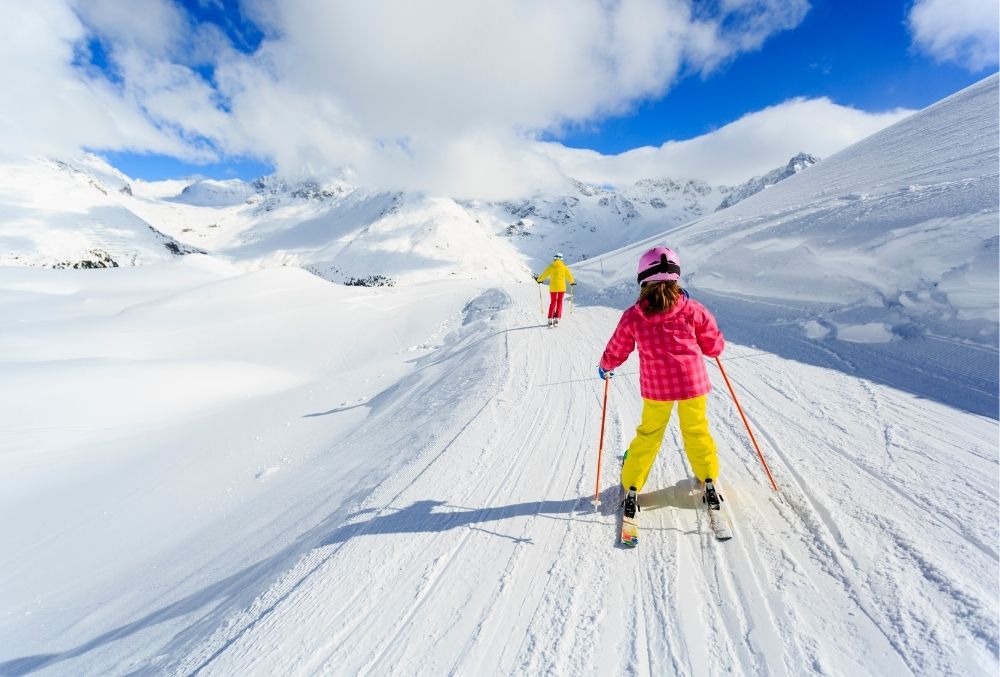
Cons Of Skiing For Beginners
There are a lot of pros to starting as a beginner on skis in terms of speed control and balance. However, it’s widely regarded that ultimately skiing is easier to learn but harder to master than snowboarding.
As you progress past the first week period on skis it becomes very apparent that you have more equipment to keep control of and master to work in synchronicity with one another.
More Equipment
As a skier, you have far more equipment to be thinking about. You have two ski poles, ski boots and two skis.
Coordinating all of this in the early stages can be intimidating and end up in crossed skis and messy falls with different parts of your equipment ending up on either side of the slope, which although can be amusing to see, is quite annoying when trying to relocate your skis and clip them back on with your boots and bindings full of snow.
Bindings
Although bindings have their perks. They can be annoying when learning to ski. Each time you fall and your skis come off, the bindings fill with snow, as do your boot bottoms.
Getting your boots to clip back in can be tough as it requires removing all of the consolidated snow out of the bindings and boots for them to click back in.
All the while you are trying not to fall face first in the snow whilst navigating this on a 25% slippery slope, trying to avoid chasing individual skis down the mountain whilst sliding on your face. We’ve all been there…
Turning
Learning to turn properly on skis is challenging because you have to keep both skis in perfect symmetry carving together. There are also 4 edges to think about rather than 2 on a snowboard.
Where it starts to get slightly more complex is the weight distribution over separate skis depending on the steepness of the slope and the angles you are carving.
In some cases, you are working both skis differently at different angles and pressures on the snow. But this is starting to progress more into the intermediate level of learning.
Catching An Edge
Catching an edge is when you are going along happily thinking how wonderful skiing is when suddenly BAAAAM, you catch one of the edges of your skis in the snow and before you know it you’re on your ass and missing both your skis with a mouth full of snow.
This usually happens when you are going straight and skiing on the flat parts of the skis, normally when trying to maintain your speed. What makes catching an edge easier to do on skis is the fact that you are negotiating to keep two skis flat at the same time, instead of one like on a snowboard.
Pros Of Snowboarding For Beginners
Snowboarding is cool, there’s no arguing that. It has a casual look about it that can look effortless once you’ve got past the awkward beginning phase, and it tends to attract a certain type of person.
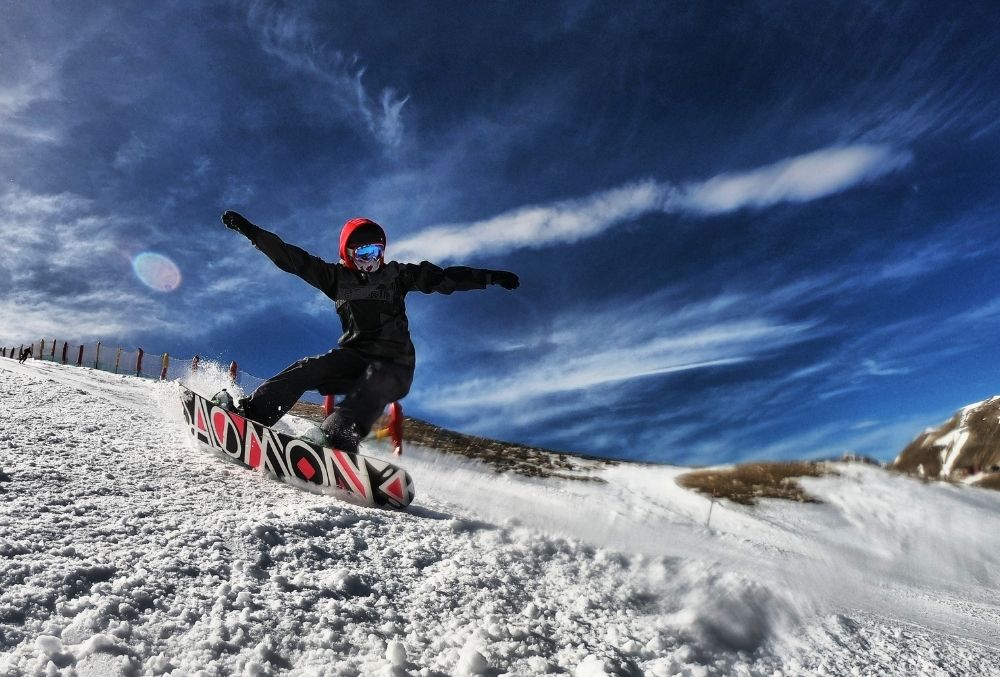
If you are someone that has always been drawn to sports where you’re facing sideways, skating, surfing, kitesurfing, wakeboarding etc, then there is a good chance that you will fall in love with snowboarding.
Less Equipment
Something very attractive about snowboarding is its simplicity in comparison to skiing. It’s just you and the board!
This can make things easier in the minds of many. Ultimately it’s less to coordinate on the slopes and less to remember after the cafes.
When you fall on a snowboard everything stays attached to you. So there is no searching the slopes and forests for missing poles and skis. You just hop back up, probably with quite a sore ass, and crack on.
Easier To Master
As a generalization, it’s widely understood that snowboarding is easier to ‘master’ than skiing. On a snowboard, you have two edges to think about, your front edge and your back edge.
Focusing only on a single transition between turns as opposed to skiing where you have 4 edges to think about both requiring different adjustments during each transition.
Off-piste
Although skis have come a long way with recent developments in width, snowboards remain superior off-piste due to the width of the board and its ability to sit on top of the powder whilst going off-piste and maintaining speed.
This allows a snowboarder to float more across the deep powder.
Hands-free
Having your hands free as a snowboarder is a nice feeling. Slightly tapping into the point above of less equipment, also gives you a sense of confidence knowing you can use your hands if need be.
This can be very assuring for beginners as it’s simply less to think about and gives you the option of grabbing onto a tree, pilon or person if panic strikes, although I don’t recommend it.
It’s also nice for small things like adjusting your boots, helmet and goggles, and reaching into pockets for ski passes/money or grabbing your mate if he sprays you with a mouth full of snow.
Boot Comfort
A huge plus for snowboarders, especially beginners, is the comfort of snowboard boots in comparison to ski boots. Snowboard boots are far more supple and comfortable with more flexibility and soft points. Making them easier to take on and off and making walking around far easier.
You can even grab a beer in them and do the moonwalk if you fancy it.
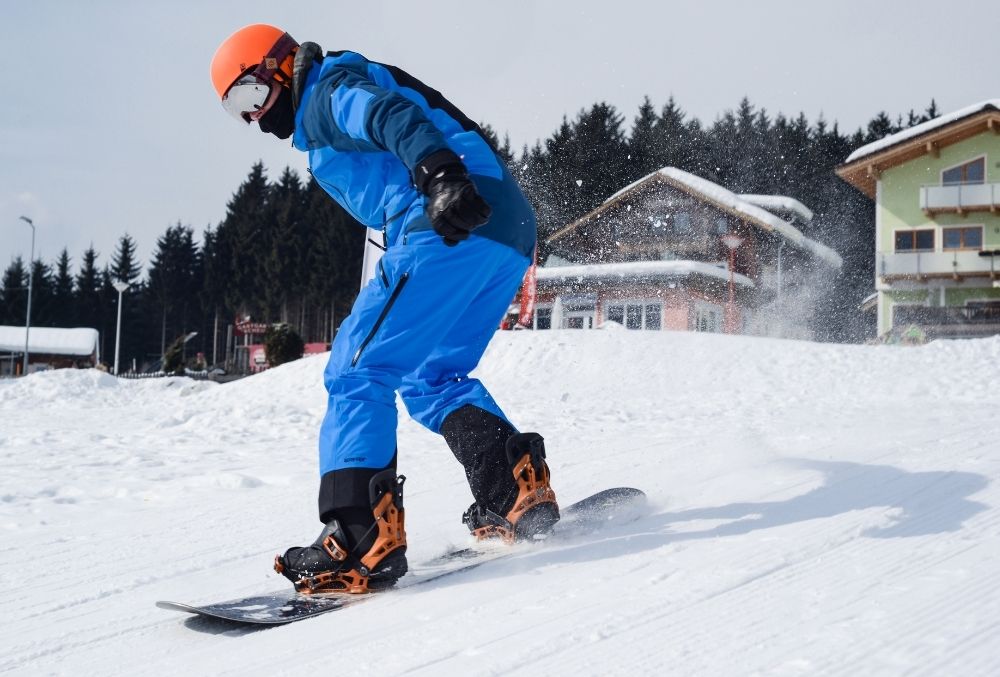
Cons Of Snowboarding For Beginners
Balance
When starting on a snowboard, balance can be a tricky thing to get the hang of.
For a lot of people, facing sideways feels foreign and unnatural. The balance point between falling forwards and backwards is sensitive when you aren’t used to it and can be the thing that most beginners get hung up on.
Unlike skiing, you can’t pull one leg out when you feel yourself falling. Once you start losing balance on the board you’re most likely ending up on your ass or your face. This is why many say that snowboarding is harder to learn than skiing.
Vison
On a snowboard, you only have 50% forward vision. This can put many off trying it as it makes sense to want to see as much as possible. Only as you make your turns do you start to see what is in front of you and to the side.
It can also be tiring on the neck having it always turned in one direction, but of course, you get used to this over time.
Chair Lifts, T-Bars & Buttons
A moment all beginners dread is when there is a queue of 50 people behind you watching as you try to navigate your board and body onto the lift without falling ass over head.
Snowboarding can be tricky because you have to awkwardly shuffle one foot along the snow whilst the other foot remains stuck in the bindings twisting your knee at an uncomfortable angle.
All the while trying to line up correctly for the chair lift. If you do manage to get on without falling then you spend the whole lift dreading getting off at the other end.
When the moment comes you have to adopt this strange technique of putting the loose foot onto the middle of the board, and try to snowboard with one foot unstrapped to safety, hoping the lift doesn’t knock you on the ass on its way round.
No Poles
I think one of the most obvious struggles as a snowboarder, especially a beginner, is the fact that you can’t pole on the flats or slight uphill sections.
Once you lose your speed there isn’t much you can do, and if you are still hundreds of meters away from the next lift or cafe, then walking is your best bet.
Sometimes getting a friendly skier to pull you along is possible, but that’s assuming you’ve made some friends, and it’s never a nice feeling having to rely on others.
Traversing
Traversing on snowboards is difficult. The way the board sits in the snow is different to a ski. As a result, they struggle to hold their line as effectively as skis.
So when you need to maintain your altitude to make it across the mountain to the linking piste to get home, snowboards tend to slide down far more quickly, and you can’t pole either if you need to keep your speed to make it.
Stopping
As a skier, you are taught the ‘snow plough’ to stop or regulate your speed. This is a fairly easy skill to learn from the beginning and stops you from falling unnecessarily.
Snowboarding is a different story. Learning to slide the board sideways to slow down takes a lot more skill and balance, and this is the only way to stop on a snowboard.
So until you master it, which can take a while, you have to surrender yourself to fall on your ass each time you want to stop. Which can quickly become very uncomfortable.
Final Thoughts
Both skiing and snowboarding have their challenges and perks. Both are undeniably great fun and worth putting in the time to learn.
As a consensus, skiing is easier to learn but harder to master due to the points listed above. Whereas snowboarding is harder to learn but easier to master.
As a beginner starting, I’d suggest thinking about what stands out to you first. For some people, skiing screams to them. Others can’t imagine doing anything but snowboarding.
After assessing the basic differences between the two and how they may affect your learning, go at it with perseverance and belief and you’ll be amazed at the results. Take your time, get a feeling for the snow and your equipment, and enjoy the beauty of the ride.
- Types of Skiing Terrains: A Comprehensive Guide for Every Skier - December 6, 2024
- Skiing Nutrition: Essential Nutritional Advice and Meal Planning for Skiers - August 15, 2024
- Backcountry Skiing Explained: Essential Tips and Gear - August 8, 2024

